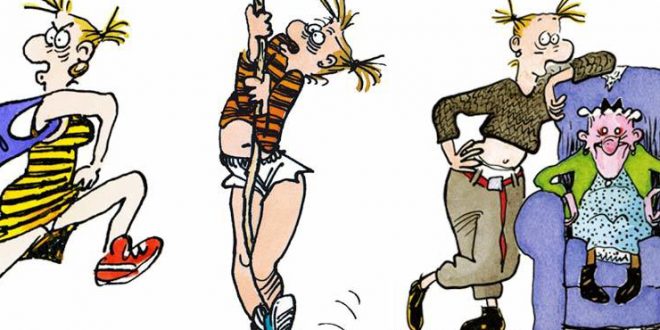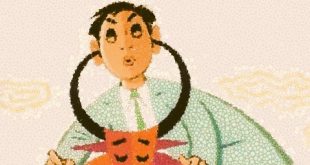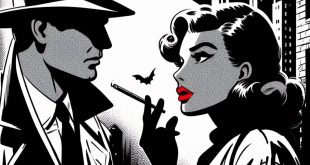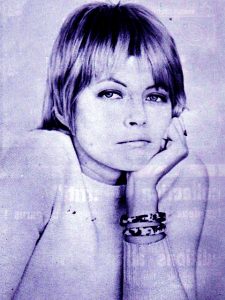 Satirical strips describing the eccentricities of French society
Satirical strips describing the eccentricities of French society
Her Agrippina, a grumpy teenager with boots on and short hair, was born in the late 1980s. As a comic book author, behind that character she covered gender and sexuality with a biting humor. For her stories, it is not by chance that Claire Bretécher has become a point of reference of the ninth art https://www.bibliotecasalaborsa.it/proposte-di-lettura/bibliography/claire_bretcher/. Asteroid 236463 was name after her, and reggae band Cookie Dingler mentioned her in their song Femme libérée. Among her works, we remember The states of mind of Cellulite, The ecological loves of western Bolot and The Anguish of Cellulite. In 2001, Canal + released 26 episodes of its Agrippine series.
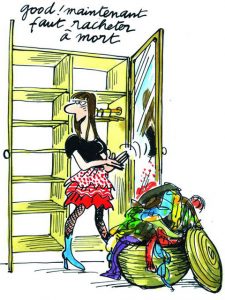
 The French cartoonist Claire Bretécher https://www.rsi.ch/play/tv/-/video/incontro-con-claire-bretecher?urn=urn:rsi:video:12736890 was born in Nantes on an April day in 1040. At a very young age, in 1963 she made her graphic debut with René Goscinny, then continuing to offer herself to an ever-wider audience on the comic weeklies Spirou and Tintin. She collaborates on an issue of the Journal Record, while with her character Cellulite she stigmatizes the excesses of feminism in the newspaper Pilote. With her tables of the Frustrati, at the turn of the seventies and eighties, on the pages of a weekly, she had described the French youth: middle-class leftists on the sofa, cigarette in hand. She have masterfully drawn, with cynicism and irony, the French left and feminism of the seventies.
The French cartoonist Claire Bretécher https://www.rsi.ch/play/tv/-/video/incontro-con-claire-bretecher?urn=urn:rsi:video:12736890 was born in Nantes on an April day in 1040. At a very young age, in 1963 she made her graphic debut with René Goscinny, then continuing to offer herself to an ever-wider audience on the comic weeklies Spirou and Tintin. She collaborates on an issue of the Journal Record, while with her character Cellulite she stigmatizes the excesses of feminism in the newspaper Pilote. With her tables of the Frustrati, at the turn of the seventies and eighties, on the pages of a weekly, she had described the French youth: middle-class leftists on the sofa, cigarette in hand. She have masterfully drawn, with cynicism and irony, the French left and feminism of the seventies.

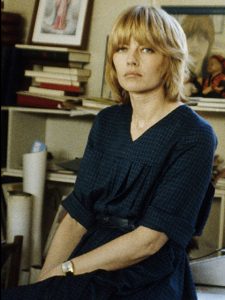 Having moved to Paris at the age of 19, she began her adventure in comics by collaborating with the screenwriter of Asterix. With satire against her contemporaries, again in Spirou magazine, Claire Bretécher https://www.izneo.com/en/author/claire-bretecher-600 evolves her style, approaching the graphics of Jean-Marc Reiser. Together with Gotlib and Mandryka, in 1972, she creates L’Eco delle savane, she collaborates with the ecological monthly Le Sauvage and, with her series Les Frustrés and with the Nouvel Observateur, she begins the collaboration that will make her famous.
Having moved to Paris at the age of 19, she began her adventure in comics by collaborating with the screenwriter of Asterix. With satire against her contemporaries, again in Spirou magazine, Claire Bretécher https://www.izneo.com/en/author/claire-bretecher-600 evolves her style, approaching the graphics of Jean-Marc Reiser. Together with Gotlib and Mandryka, in 1972, she creates L’Eco delle savane, she collaborates with the ecological monthly Le Sauvage and, with her series Les Frustrés and with the Nouvel Observateur, she begins the collaboration that will make her famous.
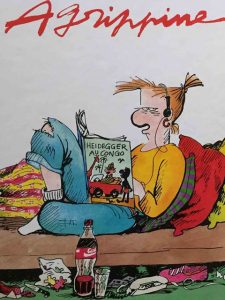
 Since 1967, her comic strip Le Gnangnan featured three children with very round heads who mocked the world of adults. In 1976, the strips of Frustrati drawn by Claire Bretécher https://www.franceculture.fr/personne-claire-bretecher become one of the most politicized chronicles of the weekly in which they appear. With great success, she began to publish her own albums, so at the beginning of 1981 she interrupted the weekly collaboration L’Observateur. She paints with talent not only comics, because a series of color portraits are collected in the Moments de lassitude, which she published in 1999.
Since 1967, her comic strip Le Gnangnan featured three children with very round heads who mocked the world of adults. In 1976, the strips of Frustrati drawn by Claire Bretécher https://www.franceculture.fr/personne-claire-bretecher become one of the most politicized chronicles of the weekly in which they appear. With great success, she began to publish her own albums, so at the beginning of 1981 she interrupted the weekly collaboration L’Observateur. She paints with talent not only comics, because a series of color portraits are collected in the Moments de lassitude, which she published in 1999.
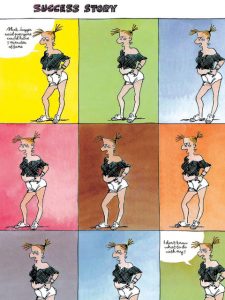
 Cartoonist and painter, she refused computer drawing; yet, with her irony she has traced an indelible path in the world of comics. For over forty years, with your satirical strips you have been describing the eccentricities of French society. The bare style of the comics drawn by Claire Bretécher relentlessly reaches its readers, correctly defining a profile in which they recognize themselves: wealthy, intellectual and disillusioned. She died in Paris in February 2020, leaving us five series of her Frustrati, eight by Agrippina and eighteen other books. https://www.amazon.com/Books-CLAIRE-BRETECHER/s?rh=n%3A283155%2Cp_27%3ACLAIRE+BRETECHER
Cartoonist and painter, she refused computer drawing; yet, with her irony she has traced an indelible path in the world of comics. For over forty years, with your satirical strips you have been describing the eccentricities of French society. The bare style of the comics drawn by Claire Bretécher relentlessly reaches its readers, correctly defining a profile in which they recognize themselves: wealthy, intellectual and disillusioned. She died in Paris in February 2020, leaving us five series of her Frustrati, eight by Agrippina and eighteen other books. https://www.amazon.com/Books-CLAIRE-BRETECHER/s?rh=n%3A283155%2Cp_27%3ACLAIRE+BRETECHER
The sole purpose of this site is to spread the knowledge of these creative people, allowing others to appreciate their works. If you want to know some already published cartoonists, you can type https://meetingbenches.com/category/cartoonists/. The intellectual properties of the images appearing in this blog correspond to their authors.
 Meeting Benches World art in all forms
Meeting Benches World art in all forms
